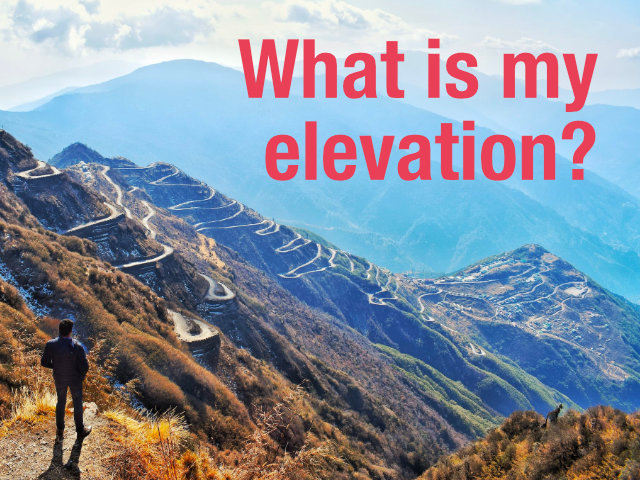Find the Elevation of Any Location
Use this search tool to find the elevation above sea level for any city in the world.
Your Guide to Understanding Elevation
Welcome! This tool helps you instantly find your current elevation (your height above sea level). While we first estimate your location by your IP address, this can be inaccurate. For a precise reading, please use the "Find My Elevation" button, which uses your device's GPS.

What's the Difference Between Elevation and Altitude?
In everyday language, "elevation," "altitude," and "height above sea level" are often used interchangeably. Technically, elevation refers to the height of a point on the Earth's surface, like your current location. Altitude typically measures an object's height above the ground, such as a plane in the sky.
Whether you're curious about your current altitude or need the elevation for a specific spot, you're in the right place. For a broader view, explore our interactive elevation map.
How to Check Elevation on Your Phone
Your smartphone is a powerful altimeter. It uses GPS and other sensors to provide accurate elevation data. We've created simple guides to help you check your elevation on an iPhone and find your altitude on Android.
How Elevation Shapes Our World
Elevation significantly impacts climate and where people live. Most of the world's population is concentrated in coastal lowlands below 150 meters (500 feet). However, some cultures have remarkably adapted to high-elevation life. In the Tibetan Plateau, for example, people thrive at elevations up to 5,334 meters (17,500 feet), where the air is thin and the climate is harsh.
The Highest and Lowest Points on Earth
The highest point on Earth is the summit of Mount Everest, on the border of Nepal and China, soaring to 8,848 meters (29,035 feet).
In contrast, the lowest point of land is the shore of the Dead Sea, bordering Israel and Jordan, which lies about 420 meters (1,385 feet) below sea level.
Elevation of the New 7 Wonders of the World
The New 7 Wonders of the World are iconic landmarks chosen by a global poll. Their elevations are as diverse as their locations.

- Great Wall of China
- Varies greatly, with some sections reaching over 1,000 meters (3,280 feet).
- Petra, Jordan
- Located in a valley at an elevation of around 810 meters (2,657 feet).
- Christ the Redeemer, Brazil
- Stands atop Corcovado Mountain at an elevation of 710 meters (2,330 feet).
- Machu Picchu, Peru
- Sits in the Andes Mountains at a breathtaking 2,430 meters (7,970 feet).
- Chichen Itza, Mexico
- Situated on a flat peninsula at an elevation of just 22 meters (72 feet).
- Roman Colosseum, Italy
- Located in Rome at an elevation of about 24 meters (79 feet).
- Taj Mahal, India
- Rests on the banks of the Yamuna River at an elevation of 171 meters (561 feet).
How Elevation Can Affect Water Quality
Did you know elevation can influence tap water quality? Higher-elevation sources are often purer, as the water flows through less populated and polluted land.
For example, mountainous countries like Austria are known for excellent tap water, such as the high-quality tap water in Vienna. Similarly, Tokyo's safe tap water comes from mountain reservoirs. In contrast, low-lying cities like Bangkok may face more water treatment challenges.
Elevation Around the World
This tool helps you instantly find your current elevation (your height above sea level). While we first estimate your location by your IP address, this can be inaccurate.
For a precise reading, please use the "Use device GPS" button, which uses your device's GPS to determine your exact position.
Explore how elevation varies dramatically across our planet, from the world's highest capital cities perched in mountain ranges to the lowest points on each continent.
Understanding elevation is crucial because it significantly influences climate patterns and where people choose to live. Learn more about how elevation affects climate and discover which US cities rank highest.